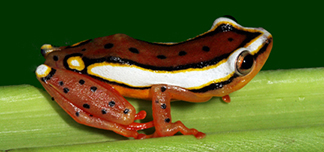| Publication Type: | Journal Article |
| Year of Publication: | 2003 |
| Authors: | M. Fabrezi, Emerson S. B. |
| Journal: | Journal of Zoology |
| Volume: | 260 |
| Pagination: | 41-51 |
| Date Published: | May |
| Keywords: | Dimorphognathus, odotoids |
| Abstract: | The anuran lower jaw is composed of three pairs of bones: dentaries, angulosplenials and mentomeckelians. Although the lower jaw is toothless, except in Gastrotheca guentheri, enlarged fangs or odontoids have evolved at least four times independently in some myobatrachids, hylids, ranids and leptodactylids through both parallel and convergent evolutionary events. Fangs seem to represent the single best design solution to enable an anuran to inflict a bite-like wound, but the biological role of biting varies among species. Fangs are projections of the dentaries in ranids, but in the hylid frog Hemiphractus and in ceratophryine leptodactylids, they form a sinosteotic unit with the dentaries and mentomeckelians. Comparisons of morphology, behaviour and diet among frog taxa with enlarged fangs reveal that the fangs may be the result of either sexual or natural selection. Those fangs that evolved in response to sexual selection seem to be relatively larger than those that resulted of natural selection. |
